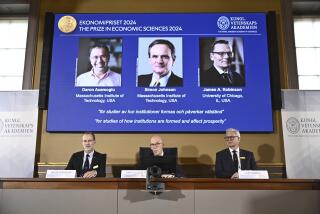Pioneering scientists behind gravitational wave discovery among Kavli Prize winners
Nine scientists have won the 2016 Kavli Prize for their groundbreaking work on gravitational waves, brain plasticity and atomic force microscopy.
The Kavli Prize, whose laureates are awarded every two years in Norway, recognizes researchers who have made crucial contributions to the fields of astrophysics, nanoscience and neuroscience. In each of the three categories, winners share a $1-million cash prize.
MITâs Rainer Weiss and Caltechâs Kip Thorne and Ronald Drever took home the astrophysics prize for their pioneering work on the Laser Interferometer Gravitational-Wave Observatory, or LIGO. After a decades-long search, LIGO in September finally detected the first direct evidence of these elusive ripples in the fabric of the cosmos.
See the most-read stories in Science this hour >>
âThis discovery has in a single stroke and for the first time, validated Einsteinâs theory of general relatively for very strong fields,â said Mats Carlsson of the Institute of Theoretical Astrophysics in Norway, chair of the astrophysics award committee, in announcing the prize Thursday. âIt has established the nature of gravitational waves, demonstrated the existence of black holes with masses 30 times that of our sun, and opened a new window on the universe.â
Thorne and Weiss, who were watching the award ceremony via video feed at the World Science Festival in New York City, embraced over a dining table and drew a standing ovation from the gathered scientists. The win came just days after the trio picked up the Shaw Prize in Astronomy for their work on LIGO.
Thanks to LIGO, âyou can really look out into the universe with a tool youâve never had before,â MIT physicist Nergis Mavalvala told the audience in New York during a panel discussion following the announcement.
Mavalvala told the audience that she didnât even know what gravitational waves were in 1991 when she met Weiss (who went on to become her doctoral advisor).
âHe told me what he was trying to do and I thought it was totally insane,â Mavalvala said. (In spite of her apparent skepticism, the 2010 MacArthur âgeniusâ grant recipient ended up working on LIGO too.)
Weiss initially came up with the concept for the detector; Thorne, who met Weiss when they shared a hotel room, was a theorist by training and recruited Drever from Scotland, who was known as a talented experimentalist.
âThe first time we actually understood that the signals are out there and measurable came really from the work of Kip â the measurable part,â Mavalvala said.
Gerd Binnig, formerly of the IBM Zurich Research Laboratory, Christoph Gerber of the University of Basel and Calvin Quate of Stanford University earned the nanoscience award for developing the atomic force microscope, an instrument that allows researchers to examine a surface practically atom by atom.
âBased on this technique, sculpting and analyzing nanoscale structures is now widely used in the fields of physics, chemistry, biology and materials science,â said Arne Brataas of the Norwegian University of Science and Technology, chair for the nanoscience award.
Michal Lipson, an expert in silicon photonics at Columbia University who also won a MacArthur grant in 2010, emphasized the importance of the Kavli winnersâ contribution to a vast array of scientific disciplines.
âThere is not a single center without this AFM, atomic force microscope,â she said at the panel discussion. âThis is a must, it is a tool that all of us use all of the time. So it has completely enabled nanotechnology to be what it is today.â
Eve Marder of Brandeis University, Michael Merzenich of UC San Francisco and Stanfordâs Carla Shatz won the neuroscience prize for their individual lines of work on the ways that experience and neural activity can reshape brain function.
Our brains are constantly responding and adapting to experience â making them incredibly plastic â and yet our personalities and behaviors somehow manage to remain largely stable, said Ole Petter Ottersen of the University of Oslo, the neuroscience chair.
âIt is the elucidation of this delicate balance between plasticity and stability that we celebrate,â he said of the laureatesâ work.
For a long time, researchers thought that babiesâ and childrenâs brains were capable of incredible plasticity and growth, but that adultsâ brains had a largely fixed architecture. The three scientists showed that the adult brain can be far more flexible and adaptable than previously thought â which opens the door to new treatments for all kinds of neurological conditions.
âThe picture of how we experience the world around us has been utterly redrawn,â Ottersen added.
The Kavli Prize is a joint effort by the Norwegian Academy of Science and Letters, the U.S.-based Kavli Foundation and the Norwegian Ministry of Education and Research.
Follow @aminawrite on Twitter for more science news and âlikeâ Los Angeles Times Science & Health on Facebook.
MORE FROM SCIENCE
Recipe for âhot Jupitersâ often includes two stars, study finds
Could mysterious gamma-ray burst be linked to gravitational wave find?
Inspired by evolution: Caltech bioengineer is first woman to win $1.1-million tech prize







